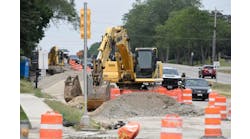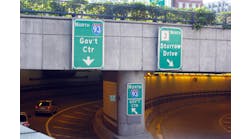The Kentucky Transportation Cabinet (KYTC) used an unbonded overlay project on I-265, the Gene Snyder Freeway, as a testing ground for new methods, designs and specifications—most notably a new QA/QC specification.
The challenging two-mile project included large
penalties/incentives, high traffic volumes, traffic maintenance on 16 ramps and
a tight work area. Contractor Gohmann Asphalt and Construction Inc.,
Clarksville, Ind., completed the job ahead of schedule.
The project won an Excellence in Concrete Paving award from the Ohio-Kentucky Chapter of ACPA, and was a finalist in the national ACPA awards competition.
Reaching a new beginning
According to Robert Harris, KYTC district construction
engineer, the existing concrete road had numerous cracks, joint faulting and
severely deteriorated ride quality.
“It had reached the end of its useful life,” he said.
KYTC decided to explore a concrete solution. “Kentucky
has traditionally rehabilitated concrete pavement with asphalt overlays,”
said Harris. “It’s just been in recent years that the department is
evaluating the concrete alternative.”
The design called for 9 in. of plain concrete on an
open-graded asphalt bond breaker with staggered joint spacing (12 to 18 ft).
The contractor used Type C fly ash as a partial cement replacement to assure
the pavement was open to traffic quickly and economically. They replaced the
existing asphalt shoulders with full-depth concrete.
A contract to speed
This project featured A+B bidding, an innovative contracting
method that is becoming more common on KYTC’s high-profile projects.
“We use it on our fast-in, fast-out jobs,” said Harris. Harris knew
this project would attract a lot of attention. “The last third of the
construction involved interstate-to-interstate traffic movement in an area of
heavy industry and development,” he said.
Heavy penalties/incentives reflected KYTC’s need to
complete the job as quickly as possible. They levied a $10,000 per day
penalty/incentive for meeting the completion date and $25,000 per day road user
cost/benefit for every day the permanent lane closures were more or less than
the number of days specified. Gohmann received 100% of the maximum user-cost
incentive.
Another innovative aspect of the project was the use of the
QA/QC specification, a first for KYTC. “This was our infant version of
QA/QC,” said Harris. “We wanted to see if it was workable. We
tweaked it, and it’s working well—so well, in fact, that it’s
going to become standard procedure next year.” The specification involved
statistically evaluating strength and air content based on a percent-within-limits
criterion. Gohmann received 95% of the possible incentive payment under the
QA/QC spec.
One is enough
Traffic maintenance was truly a challenge with work-zone
traffic at 50,000 vehicles per day. The contractor had to maintain traffic on
16 ramps in three interchanges. KYTC proposed running traffic on one side of
the divided highway while working on the other side. This plan required 38
separate phases of concrete paving with numerous temporary median crossovers.
“With 16 ramps in a 2-mile stretch, the original plan was too
complicated,” said Joel Field, concrete paving division manager for
Gohmann.
The contractor proposed constructing one lane at a time to
simplify the complicated traffic maintenance scheme. This plan reduced the
number of phases to two and eliminated all temporary median crossovers. KYTC
accepted the proposal, looking to provide increased safety and convenience for
motorists. The less complex plan also saved approximately $125,000.
“The department had always felt it would be best to
remove the traffic completely from the construction zone. But the contractor
felt our traffic maintenance plan would be unworkable; he wanted to do
everything behind one-lane closures,” said Harris. “He proved he
could do the job under traffic.”
Working behind concrete barriers with only 18 in. of
clearance, Gohmann needed to do some creative thinking. To fit the equipment
into this tight area, they used a high-drive track and unique mechanical
tie-bar inserter on the slip-form paver, plus custom-fabricated string-line
holders. This was one of the first times the high-drive track, manufactured by
Gomaco Corp., was used in the U.S. Gomaco also custom made the tie-bar inserter
for this project to pull the 30-in. bent tie bar into the side of the new
pavement.
“The most innovative part of this job was being able
to perform paving with a small clearance close to traffic,” said Field.
“We had 2 ft and then a vertical wall.” He feels one-lane-at-a-time
construction will benefit the concrete paving industry. “It puts concrete
on an equal level with asphalt,” he said.
In addition to equipment modifications, Gohmann introduced a
couple of paving methods KYTC had not yet seen. Although standard for Gohmann,
dual string lines of braided aircraft cable were new to KYTC. “The cables
gave them a better shot at rideability,” continued Harris. “We
hadn’t seen string lines like that before.” The contractor also
used an early entry saw, which Harris said was new to them, “It allowed
them to get on the slab earlier and reduced random cracking.”
Nice balance
Harris deemed the project a success. “We accomplished
our objectives, with the QA/QC specification being the most positive
outcome,” he said. “The project showed concrete can be put down
under heavy traffic in a confined space.”
The main challenge of the project, according to Field, was
to “balance quality issues with time and construction
problems.” He added,
“We worked out the optimal balance.”
Field feels this project will have an impact on future paving decisions in Kentucky. “I hope it opens the door to additional opportunities for concrete pavement,” he said. This project has changed the thinking about what can be done, and gives owners more options.”


